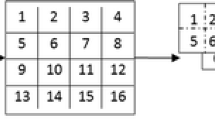Abstract
Breast cancer is the second major type of cancer that causes mortality among women. This can be reduced if the cancer is detected at its early stage but the existing methods result in a large number of false positives/negatives. Detection of masses is more challenging. A new method for mass detection is proposed that uses textural properties of masses. A Gabor filter bank is used for this purpose. The decision of how many Gabor filters must be there in the bank and the selection of the appropriate parameters of each individual Gabor filter is critical. Particle swarm optimization (PSO) and a clustering technique are used to design and select the optimal Gabor filter bank. Support vector machine (SVM) is used as an application oriented fitness criteria. The empirical evaluation of the method over 512 ROIs from DDSM database depicts that it yields better performance (99.41%) than the traditional Gabor filter bank and other state-of-the-art methods that exploit texture properties of masses.
Access this chapter
Tax calculation will be finalised at checkout
Purchases are for personal use only
Preview
Unable to display preview. Download preview PDF.
Similar content being viewed by others

References
Altekruse, S.F., Kosary, C.L., Krapcho, M., et al.: SEER Cancer Statistics Review, pp. 1975–2007. National Cancer Institute, Bethesda (2010)
Yufeng, Z.: Breast Cancer Detection with Gabor Features from Digital Mammograms. Algorithms 3(1), 44–62 (2010)
Lladó, X., Oliver, A., Freixenet, J., Martí, R., Martí, J.: A textural approach for mass false positive reduction in mammography. Comp. Medical Imag. and Graph. 33(6), 415–422 (2009)
Esteve, J., Kricker, A., Ferlay, J., Parkin, D.: Facts and figures of cancer in the European Community. Tech. rep., International Agency for Research on Cancer (1993)
Mohamed, M.E., Ibrahima, F., Brahim, B.S.: Breast cancer diagnosis in digital mammogram using multiscale curvelet transform, Comp. Medical Imag. and Graph. 34(4), 269–276 (2010)
Zehan, S., George, B., Ronald, M.: On-road Vehicle Detection Using Evolutionary Gabor Filter Optimization. IEEE Trans. on Intell. Transp. System 6(2), 125–137 (2005)
Ville, K., Joni-Kristian, K.: Simple Gabor feature space for invariant object recognition. Pattern Recognition Letter 25(3), 311–318 (2004)
Manjunath, B., Ma, W.: Texture features for browsing and retrieval of image data. IEEE Tran. on Pattern Analysis and Machine Intelligence 18(8), 837–842 (1996)
Peter, K., Nikolay, P.: Nonlinear Operator for Oriented Texture. IEEE Tran. on I. Proc. 8(10), 1395–1407 (1999)
Daugman, J.G.: Two-dimensional spectral analysis of cortical receptive field profiles. Vis. Res. 20, 847–856 (1980)
Zehan, S., George, B., Ronald, M.: Monocular Precrash Vehicle Detection: Features and Classifiers. IEEE Trans. on Image Proc. 15(7), 2019–2034 (2006)
Yu, S., Shiguan, S., Xilin, C., Wen, G.: Hierarchical Ensemble of Global and Local Classifiers for Face Recognition. IEEE Trans. on Image Proc. 18(8), 1885–1896 (2009)
Eberhartand, R.C., Kennedy, J.: Particle Swarm Optimization. In: Proc. of IEEE International Conference on Neural Networks, pp. 1942–1948 (1995)
Vapnik, V.: Statistical Learning Theory. Springer, New York (1995)
Heath, M., Bowyer, K., Kopans, D., Moore, R., Kegelmeyer, P.J.: The digital database for screening mammography. Int. Work. Dig. Mamm., 212–218 (2000)
Hsu, C.W., Chang, C.C., Lin, C.J.: A Practical Guide to Support Vector Classification, Technical report, Department of Computer Science and Information Engineering, National Taiwan University (2010)
Hussain, M., Khan, N.: Automatic mass detection in mammograms using multiscale spatial weber local descriptor. In: Proc. IWSSIP 2012, Austria, April 11-13 (to appear, 2012)
Lladó, X., Oliver, A., Freixenet, J., Martí, R., Martí, J.: A textural approach for mass false positive reduction in mammography. Computerized Medical Imaging and Graphics 33(6), 415–422 (2009)
Author information
Authors and Affiliations
Editor information
Editors and Affiliations
Rights and permissions
Copyright information
© 2012 Springer-Verlag Berlin Heidelberg
About this paper
Cite this paper
Hussain, M., Khan, S., Muhammad, G., Bebis, G. (2012). Mass Detection in Digital Mammograms Using Optimized Gabor Filter Bank. In: Bebis, G., et al. Advances in Visual Computing. ISVC 2012. Lecture Notes in Computer Science, vol 7432. Springer, Berlin, Heidelberg. https://doi.org/10.1007/978-3-642-33191-6_9
Download citation
DOI: https://doi.org/10.1007/978-3-642-33191-6_9
Publisher Name: Springer, Berlin, Heidelberg
Print ISBN: 978-3-642-33190-9
Online ISBN: 978-3-642-33191-6
eBook Packages: Computer ScienceComputer Science (R0)



